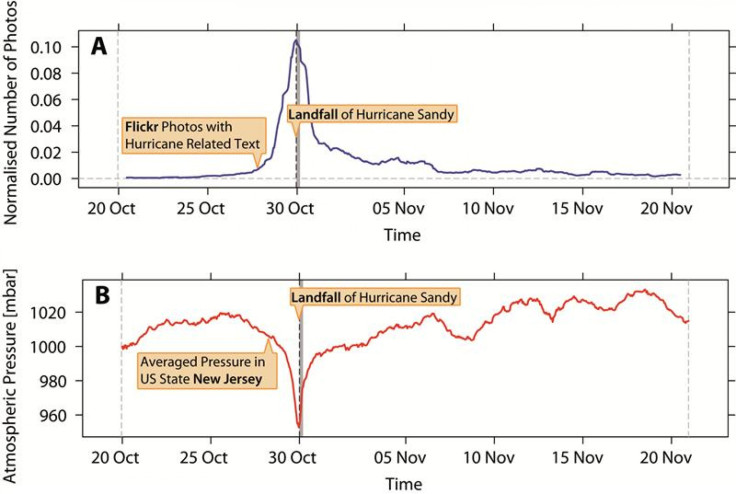Can Flickr Predict Natural Disasters? Hurricane Sandy Created ‘Digital Trace’ When Photo Uploads Peaked During Storm

In yet another positive development about the uses of social media, a new study finds it can potentially track natural disasters and other major events in real-time. Researchers found that during Hurricane Sandy, the most destructive hurricane of the 2012 Atlantic hurricane season, Flickr users increasingly uploaded photos of the storm as it barreled along the Eastern Seaboard, with the number of photos tagged “hurricane,” “sandy” or “hurricane sandy” peaking just as the storm made landfall in New Jersey.
This probably doesn’t come as a surprise to anyone familiar with social media. People react to events around them and share their reactions on Facebook, Twitter, Instagram and others. Big whoop. Scientists say the fascinating part of all this, however, is that using such online indicators could help governments measure the impact of disasters when other forms of data are not readily available.
"Flickr can be considered as a system of large-scale real-time sensors, documenting collective human attention,” Suzy Moat, Assistant Professor of Behavioral Science at the Warwick Business School in the U.K. and co-author of the study, said in a statement on the university’s website. “Increases in Flickr photo counts with particular labels may reveal notable increases in attention to a particular issue, which in some cases may merit further investigation for policymakers."
Through their analysis, scientists from the Warwick Business School found that as atmospheric pressure in New Jersey decreased – something that happens as a hurricane intensifies – so did the number of Hurricane Sandy-related Flickr uploads, and vice versa.
"Plotting the data revealed that the number of photos taken increased continuously while 'Sandy' was moving toward the coast of the U.S.,” Moat said. “This study would suggest that in cases where no external sensors are available, it may be possible to use the number of Flickr photos relating to a topic to gauge the current level of this category of problems.”
The study, published in Scientific Reports and titled “Quantifying the Digital Traces of Hurricane Sandyon Flickr,” suggests that social media could provide another tool for researchers to monitor events with publicly available data. Just as it works with natural disasters, as witnessed with hurricane Katrina, the process could also work for things like infectious diseases.
"Appropriate leverage of such online indicators of large disasters could be useful to policymakers and others charged with emergency crisis management -- in particular if no secondary environmental measures are available,” researchers noted in the report.
One might quickly point out that the reason for the correlation between Flickr photo uploads and Hurricane Sandy could simply have been the result of media coverage of the storm. You’d be hard-pressed to find someone who didn’t know Hurricane Sandy was approaching. Nearly every media outlet reported on the impending hurricane, so of course the hype encouraged people to talk about it on social media. But, as Buzzfeed noted, Flickr does seem to be more immune to media. Other social networks like Twitter and Facebook are more news-focused and allow news organizations to reach their followers directly. Flickr, on the other hand, is a site for photographers, so it doesn’t have as much of a media presence as other networks.
© Copyright IBTimes 2024. All rights reserved.






















